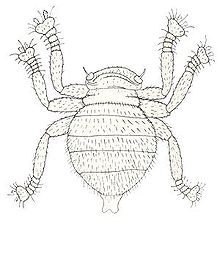Braula is a genus of flies (Diptera) in the family Braulidae. These are very unusual flies, wingless and flattened, and barely recognizable as Diptera. Braula coeca Nitzsch is a pest of honey bees. The larvae tunnel through the wax honeycomb and the adults are found on the bodies of honey bees. There is some debate whether the bee louse causes damage to the honey bee. These flies sometimes can be found at places where bees congregate such as flowers or salt licks, waiting to grab onto hosts from uninfested nests.[6] Braula is cosmopolitan and about 1.6 mm in length.
| Braula | |
|---|---|

| |
| Braula coeca | |
| Scientific classification | |
| Domain: | Eukaryota |
| Kingdom: | Animalia |
| Phylum: | Arthropoda |
| Class: | Insecta |
| Order: | Diptera |
| Superfamily: | Carnoidea |
| Family: | Braulidae |
| Genus: | Braula Nitzsch, 1818[1] |
| Type species | |
| Braula coeca | |
| Synonyms | |
Species
edit- Braula coeca Nitzsch, 1818[1]
- Braula kohli Schmitz, 1914[7]
- Braula orientalis Òròsi Pál, 1963
- Braula pretoriensis Òròsi Pál, 1939[8]
- Braula schmitzi Òròsi Pál, 1939[9][10]
References
edit- ^ a b c Nitzsch, C.L. (1818). "Die Familien und Gattungen der Thierinsekten (Insecta epizoica) als Prodromus einer Naturgeschichte derselben" (PDF). Mag. Ent. (Germar). 3: 261–316. Retrieved 19 January 2022.
- ^ Costa, A. (1846). "Storia completa dell'Entomibia apum Costa (nuovo genere d'Insetti Ditteri) e su idanni che arreca alle api da micle". Atti R. Ist. Incorag. Sci. Nat. (1847) 7: 291–306.
- ^ Rondani, C. (1879). "Hippoboscita Italica in familias et genera distributa". Bullettino della Società Entomologica Italiana. 11: 3–28. Retrieved 19 January 2022.
- ^ Bigot, Jacques-Marie-Frangile (1885). "Diptères nouveaux ou peu connus. 27e partie(1). XXXV: Famille des Anomalocerati (mihi) a??µ???—?e?a?. (Coriacae, Pupipara, Nycteribidae. auctor)". Annales de la Société Entomologique de France. 5 (6): 225–246. Retrieved 19 January 2022.
- ^ Bezzi, Mario (1905). Cyclorrhapha Schizophora: Pupipara. Pp. 273-292. In Becker, T., Bezzi, M., Kertesz, K. & Stein, P. (eds.), Katalog der palaarktischen Dipteren. Volume 4. . Budapest. pp. [i] + 328 pp.
{{cite book}}: CS1 maint: location missing publisher (link) - ^ Papp, L (1984). Soós, Árpád; Papp, Lazlo (eds.). Catalogue of Palaearctic Diptera (Print). Vol. 10. Amsterdam: Elsevier. pp. 178–180. ISBN 0-444-99601-X.
- ^ Schmitz, H. (1914). "Eine auf der afrikanischer Honigbiene schmarotzende neue Braula-Art". Archives de zoologie expérimentale et générale. 54: 121–123. Retrieved 17 June 2018.
- ^ Örösi Pál, Z. (1938). "Braula pretoriensis". Meheszet, Budapest. 35: 183–186.
- ^ Örösi Pál, Z. (1939). Mehellensegek es a kopu allatvilaga. Budapest: OrszMagyar Meheszeti Egyesulet. p. 163.
- ^ Dobson, J.R. (1999). "Bee-louse Braula schmitzi Örösi-Pál (Diptera: Braulidae) new to the British Isles, and the status of Braula spp. in England and Wales". British Journal of Entomology and Natural History. 11. British Entomological and Natural History Society: 139–148.
External links
edit- Braula coeca, bee louse on the University of Florida / Institute of Food and Agricultural Sciences Featured Creatures website
- Photograph of a bee louse